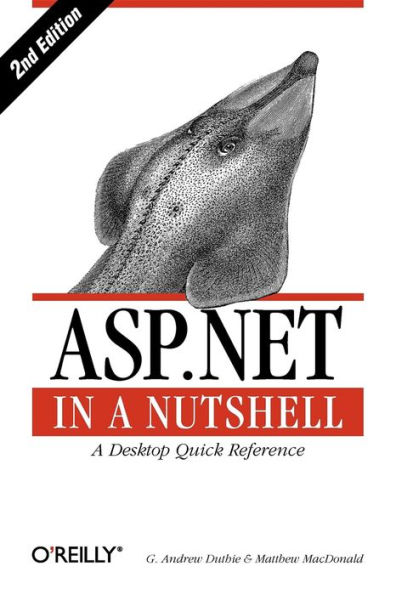5
1

ASP.NET in a Nutshell: A Desktop Quick Reference
998
by G. Andrew Duthie, Matthew MacDonald
G. Andrew Duthie

ASP.NET in a Nutshell: A Desktop Quick Reference
998
by G. Andrew Duthie, Matthew MacDonald
G. Andrew Duthie
Paperback(Second Edition)
$59.99
-
PICK UP IN STORECheck Availability at Nearby Stores
Available within 2 business hours
Related collections and offers
59.99
In Stock
Overview
ASP.NET in a Nutshell is a concise, one-volume reference to everything you need to make effective use of ASP.NET. An invaluable resource that goes beyond the published documentation to highlight little-known details, stress practical uses for particular features, and provide real-world examples that show how features can be used in a working application, ASP.NET in a Nutshell is the definitive guide for developers of both applications and web services. Updated for Visual Studio .NET 2003, the 2nd edition of this book includes fresh information on application and web service development, custom controls, data access, security, deployment, and error handling, new material on web application development for mobile devices, plus an overview of the class libraries. For developers who still use Microsoft's older ASP technology, this book also provides information for migrating to ASP.NET. The material in ASP.NET in a Nutshell is presented in three sections:
- A fast-paced introduction to ASP.NET that examines topics such as building ASP.NET applications, developing web services, creating custom controls and user controls for maximum code reuse, debugging and handling errors, understanding ASP.NET security, and configuring and deploying an ASP.NET application
- A detailed reference to the properties, methods, and events of the most frequently used ASP.NET classes which include the Page class and the new .NET classes, such as HttpApplicationState and HttpSessionState, which correspond to the intrinsic objects in classic ASP. Configuration settings in web.config are also documented
- A Quick Reference to the types (the classes, structures, interfaces, delegates, events, and enumerations) found in web-related namespaces to the .NET Framework Class Library.

Product Details
| ISBN-13: | 9780596005207 |
|---|---|
| Publisher: | O'Reilly Media, Incorporated |
| Publication date: | 08/07/2003 |
| Series: | In a Nutshell (O'Reilly) |
| Edition description: | Second Edition |
| Pages: | 998 |
| Product dimensions: | 6.00(w) x 9.00(h) x 1.86(d) |
About the Author
G. Andrew Duthie is an experienced ASP.NET developer. He is a frequent speaker at ASP.NET conferences, and is the author of a number of books on ASP.NET and Visual Interdev.
Matthew MacDonald is a developer, author, and educator in all things Visual Basic and .NET. He's worked with Visual Basic and ASP since their initial versions, and written over a dozen books on the subject, including The Book of VB .NET (No Starch Press) and Visual Basic 2005: A Developer's Notebook (O'Reilly). He has also written Excel 2007:The Missing Manual, Excel 2007 for Starters: The Missing Manual, Access 2007:The Missing Manual, and Access 2007 for Starters: The Missing Manual, all from O'Reilly. His web site is http://www.prosetech.com/.
Matthew MacDonald is a developer, author, and educator in all things Visual Basic and .NET. He's worked with Visual Basic and ASP since their initial versions, and written over a dozen books on the subject, including The Book of VB .NET (No Starch Press) and Visual Basic 2005: A Developer's Notebook (O'Reilly). He has also written Excel 2007:The Missing Manual, Excel 2007 for Starters: The Missing Manual, Access 2007:The Missing Manual, and Access 2007 for Starters: The Missing Manual, all from O'Reilly. His web site is http://www.prosetech.com/.
Table of Contents
- Copyright
- Preface
- Part I: Introduction to ASP.NET
- Chapter 1: Introduction
- Chapter 2: ASP.NET Applications
- Chapter 3: Web Forms
- Chapter 4: Web Services
- Chapter 5: ASP.NET Server Controls
- Chapter 6: User Controls and Custom Server Controls
- Chapter 7: Data Access and Data Binding
- Chapter 8: ASP.NET Configuration
- Chapter 9: ASP.NET Security
- Chapter 10: Error Handling, Debugging, and Tracing
- Chapter 11: ASP.NET Deployment
- Part II: Intrinsic Class Reference
- Chapter 12: The Page Class
- Chapter 13: The HttpApplicationState Class
- Chapter 14: The HttpContext Class
- Chapter 15: The HttpException Class
- Chapter 16: The HttpRequest Class
- Chapter 17: The HttpResponse Class
- Chapter 18: The HttpServerUtility Class
- Chapter 19: The HttpSessionState Class
- Chapter 20: web.config Reference
- Part III: Namespace Reference
- Chapter 21: Namespace Reference
- Chapter 22: Converting from C# to VB Syntax
- Chapter 23: The System.Web Namespace
- Chapter 24: The System.Web.Caching Namespace
- Chapter 25: The System.Web.Configuration Namespace
- Chapter 26: The System.Web.Hosting Namespace
- Chapter 27: The System.Web.Mail Namespace
- Chapter 28: The System.Web.Mobile Namespace
- Chapter 29: The System.Web.Security Namespace
- Chapter 30: The System.Web.Services Namespace
- Chapter 31: The System.Web.Services.Configuration Namespace
- Chapter 32: The System.Web.Services.Description Namespace
- Chapter 33: The System.Web.Services.Discovery Namespace
- Chapter 34: The System.Web.Services.Protocols Namespace
- Chapter 35: The System.Web.SessionState Namespace
- Chapter 36: The System.Web.UI Namespace
- Chapter 37: The System.Web.UI.Design Namespace
- Chapter 38: The System.Web.UI.Design.WebControls Namespace
- Chapter 39: The System.Web.UI.HtmlControls Namespace
- Chapter 40: The System.Web.UI.MobileControls Namespace
- Chapter 41: The System.Web.UI.MobileControls.Adapters Namespace
- Chapter 42: The System.Web.UI.WebControls Namespace
- Appendix A: Type, Method, Property, and Field Index
- Colophon
From the B&N Reads Blog
Page 1 of
